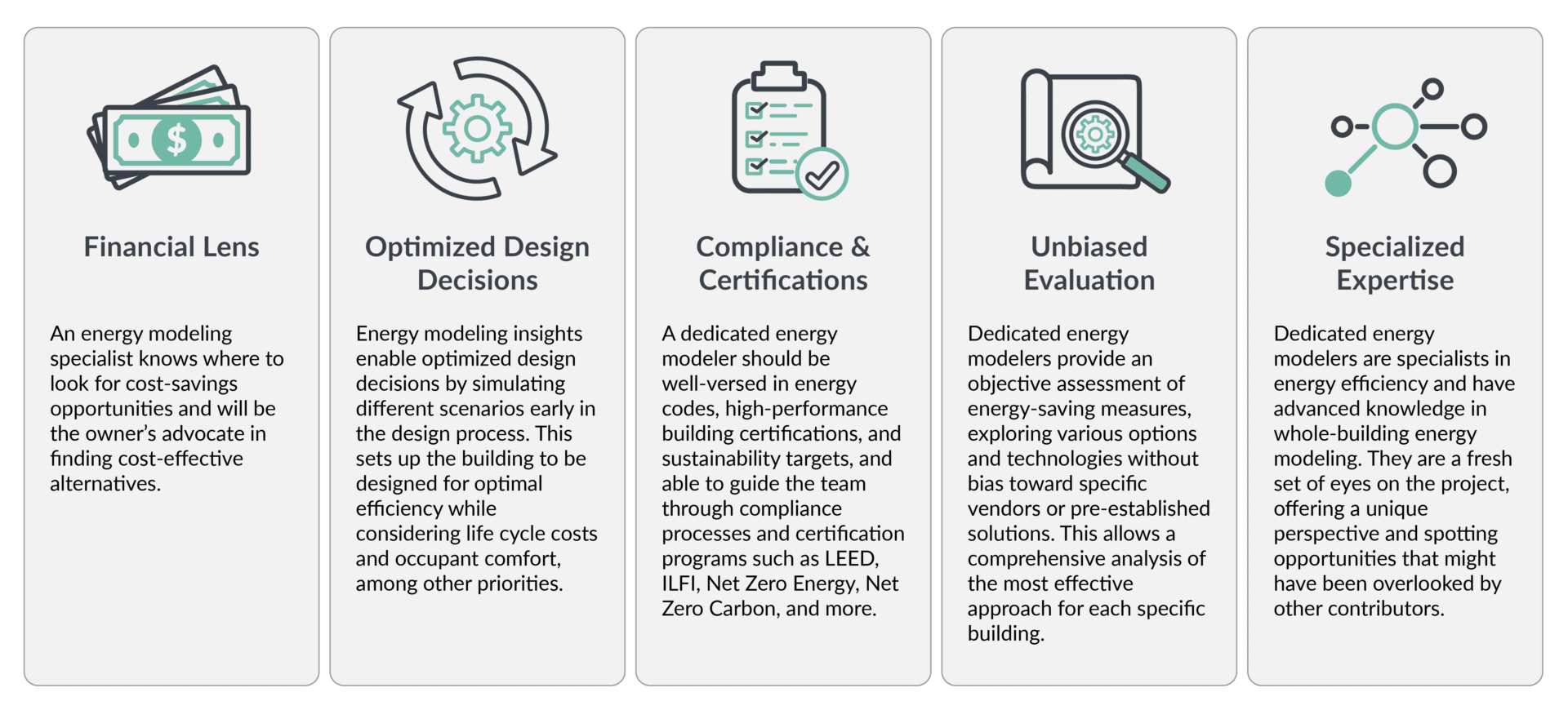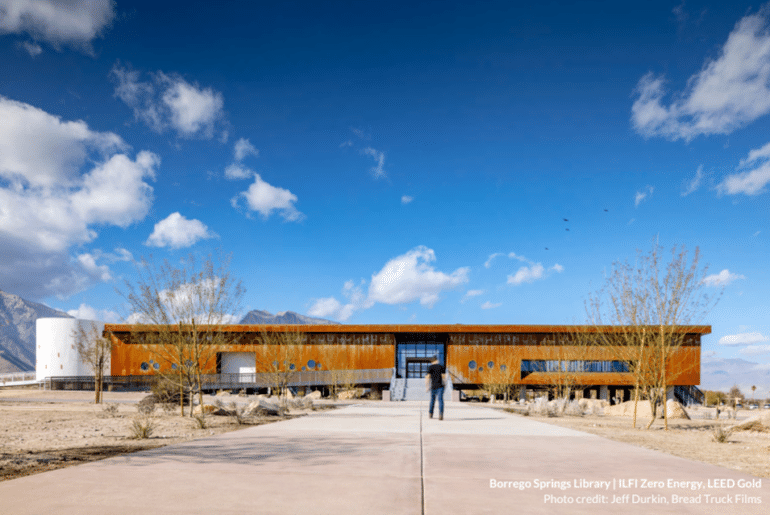What’s the best way to optimize building energy performance, life-cycle costs, and carbon emissions reductions? While building owners and architects often default to their mechanical engineer to answer this question, a dedicated energy modeler can provide enhanced value when engaged to collaborate with the design team to optimize energy, costs, and carbon emissions.
FIRST, A QUICK STORY
An owner of an existing office building in San Diego was doing a gut rehab and reskinning the building. The mechanical engineer on the project was responsible for Title 24 energy documentation. In general, there are two ways to show code compliance with Title 24: “Prescriptive” (which uses lookup tables with efficiency values that need to be met), and “Performance”, which uses a whole-building energy model to allow tradeoffs across the building’s design features to demonstrate compliance. The Prescriptive method is rigid but commonly used because it’s simple and doesn’t require any particular expertise. Conversely, the Performance method is flexible and allows for optimized solutions via tradeoffs but is more complex and requires expertise to use well.
The mechanical engineer chose to use the Prescriptive lookup values for glazing requirements, which forced the building to use a very high performance (expensive!) curtainwall system with thermal break. Using a whole-building Performance method energy model, Stok demonstrated that the building could comply with Title 24 without the thermal break on the curtainwall, reducing complexity of the design. In fact, the building actually used less energy and cost less to operate without the thermal break. And the kicker? Specifying a curtainwall without a thermal break reduced the glazing system cost by more than $600,000. Immediate payback.
CAN’T THE MECHANICAL ENGINEER JUST DO THE ENERGY MODELING?
Mechanical engineers play a vital role in designing and optimizing building HVAC systems, and their primary focus lies in the mechanical aspects of a building’s infrastructure. Energy modeling, on the other hand, requires specialized knowledge that goes beyond mechanical engineering to encompass a holistic evaluation and expertise across many building systems, and whose context includes not just the building itself but also integrates a portfolio-wide lens and global climate concerns.
Mechanical engineers:
-
- Bring valuable expertise in designing the mechanical systems of a building, including HVAC, plumbing, and fire protection.
- Ensure that these critical systems are properly sized, integrated, and meet the owner’s project requirements (OPR).
- Focus on functionality, minimum code compliance, and the overall performance of the mechanical systems.
Energy modelers:
-
- Specialize in whole building energy modeling, utilizing advanced software and analytical tools to simulate and evaluate a building’s energy consumption.
- Aim to optimize energy efficiency, find integrated opportunities for cost savings, and reduce the environmental impact of the building.
Aside from specialized expertise, what sets a dedicated energy modeler apart is their position adjacent to the traditional design team structure, which ensures their impartiality and objectivity. They provide an independent, unbiased evaluation of energy-saving and cost-reduction measures, considering a wide range of options to determine the most effective solutions for a project.
BUILDING OWNER, DEVELOPER, AND ARCHITECT NEEDS
In Stok’s experience, stakeholders on a high-performance project have many priorities.
Building owners and developers often aim to:
-
- Reduce first costs and long-term costs to improve financial returns
- Maintain occupant comfort and satisfaction so that people are happy and productive
- Differentiate their property to stand out within the market
- Understand regulatory compliance (e.g., Title 24 requirements for new buildings, energy reporting for existing buildings, etc.)
- Demonstrate environmental stewardship and reduce the environmental impacts of building design, construction, and long-term operation, including through building certifications such as LEED, ILFI, Net Zero Energy, Net Zero Carbon, etc.
Building architects also work toward:
-
- Design excellence for functional and innovative spaces
- Occupant experience and well-being
- Sustainable design requirements like LEED, ILFI, Net Zero Energy, Net Zero Carbon, etc.
- Collaboration and teamwork among the design team
- Technical compliance and constructability
As the building owner or architect, hiring a dedicated energy modeler means securing expertise to accomplish the owner goals and advocating for what matters most to the owner. This demonstrates a commitment to energy efficiency and sustainability, setting the building apart, attracting the best tenants, and enhancing its future performance and increasing asset value (a more efficient building is a more valuable building!).
WHAT ARE THE BENEFITS OF HAVING A DEDICATED ENERGY MODELER ON THE TEAM?
To spell it out, F-O-C-U-S. Let the expert engineers focus on their areas of expertise; let the energy experts focus on increasing energy efficiency and reducing life cycle costs. When everyone is working in their areas of expertise – and working together towards a common goal – the project is more likely to achieve the intended results. A dedicated energy modeler will bring FOCUS:


IS THERE ROOM ON THE TEAM FOR BOTH A MECHANICAL ENGINEER AND A DEDICATED ENERGY MODELER?
We strongly believe that not only is there room, but there is a need for both a mechanical engineer and a dedicated energy modeler on the design team. In fact, collaboration between the two can greatly enhance the overall design process and lead to more efficient buildings and subsequent returns.
By having both a mechanical engineer and an energy modeler on the design team, owners, developers, and architects benefit from a synergistic collaboration that combines their respective areas of expertise. The mechanical engineer can provide valuable input on system design, equipment selection, and operational considerations, while the energy modeler can offer insights on cost-savings options, energy-saving strategies, and decarbonization opportunities. This is an example of 1+1=3!
WHEN IS THE BEST TIME TO BRING ON AN ENERGY MODELER?
By involving a dedicated energy modeler from the get-go – ideally as soon as the initial design concepts are being developed, if not earlier – the design team can maximize the benefits they bring to the table.
When cost-effectiveness, energy-efficiency, and sustainability are priorities, Stok is often brought onto the team before other consultants – including mechanical and electrical engineers, and even architects. Early collaboration allows us to work closely with the whole team to integrate energy performance considerations right from the start. Together, we explore different design options, evaluate their impact on energy efficiency, and identify opportunities for improvement while considering other project objectives such as functionality, aesthetics, and cost.
Imagine waiting until the end of design to learn about the huge cost savings opportunities of the earlier curtainwall example. By then, the architect has already completed detailing the curtainwall system with a thermal break. HVAC system design is already complete based on the loads from the thermally-broken system. Maybe procurement has already begun. Any changes to the design at this point will be difficult, expensive, and maybe even impossible! Even in this simple example, the benefit is maximized by bringing in a dedicated energy modeler early.
IN SUMMARY
So, on the next project, remember there might be an opportunity for FOCUS:
-
- Financial lens
- Optimized design decisions
- Compliance and certifications expertise
- Unbiased evaluation
- Specialized expertise
And remember that all of the values of energy modeling are maximized much earlier than in Design Development (DD), when impactful options are easier and more cost-effective to implement.
Reach out to Stok to discuss your project. Our dedicated energy modelers maintain industry-leading specialty certifications like ASHRAE BEMP (Building Energy Modeling Professional) and CABEC CEA (Certified Energy Analyst) as well as PE (Professional Engineer) licenses across multiple states. We’re also human beings who can translate this expertise into everyday language that is easy to understand!



